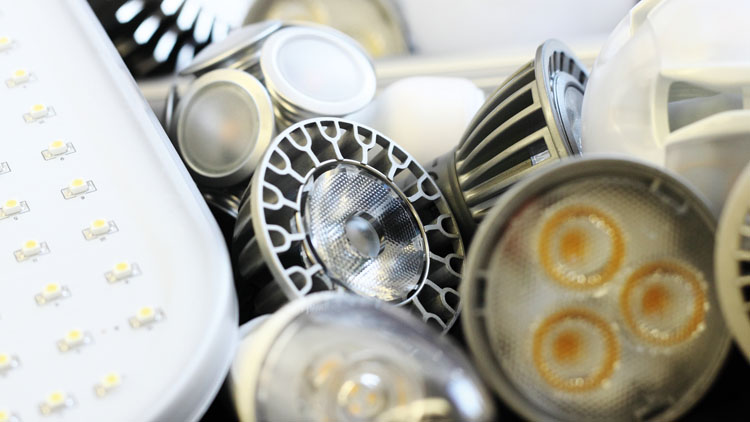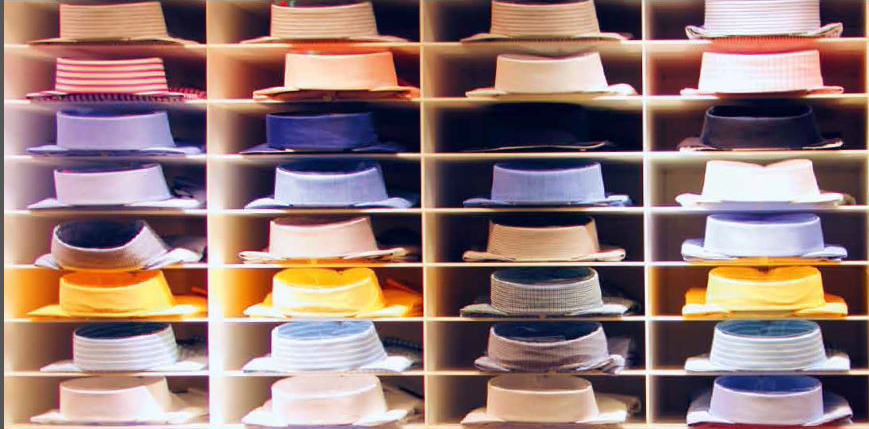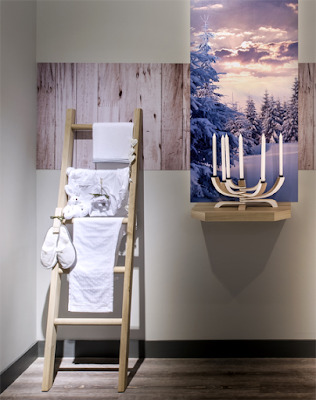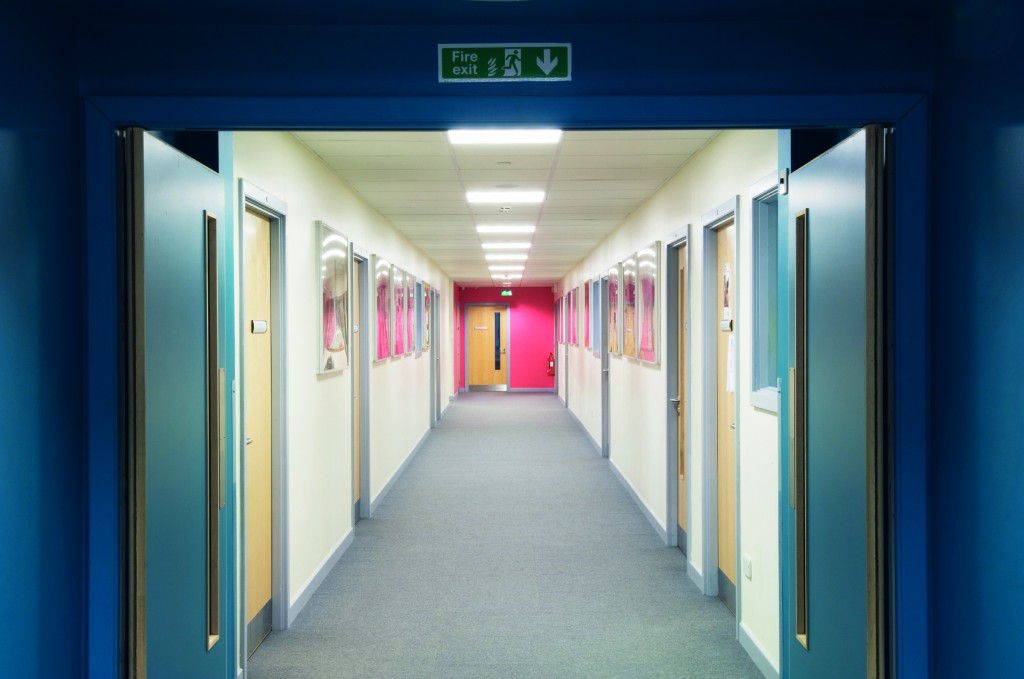
The right lighting in an office can make all the difference – like in this Berlin office lit by Selux
Lux report: It’s summer and there’s light all around us – we take it for granted until those dark winter months come along. The sheer lack of sunlight can be depressing. Every year we experience this longing for summer, craving those long, bright days when we feel energetic and in a good mood. The sad news is, we’ve again passed the longest day of 2015, but the good news is that the right artificial lighting in your workplace can help you through.
Good lighting creates pleasant working conditions in a functional and atmospheric way. Satisfaction and efficiency will improve if you make sure you have enough daylight intake and a well-lit office space. Plus, your productivity will be positively affected by well-designed illumination. Artificial lighting that does not just help you see, but also meets your biological lighting needs, is the future of office lighting.
Here are six lighting hacks to keep you healthy and alert through those dark winter days.
1 Create atmospheres where your ideas can develop
We’re all attracted to light, and there isn’t any other medium that has as big an influence on our bodies and minds as light. Both daylight and artificial light play a key role in our health and wellbeing.
In companies with a high standard of interior design, productivity can increase”
Increasingly, companies face the question of how they can improve staff wellbeing and create a dynamic, creative and motivating environment. The design of the office space plays a vital role, as evidenced by a study from Germany’s Fraunhofer Institute for Industrial Engineering. The research shows that in companies with a high standard of interior design, productivity can increase by up to 36 per cent. Who wouldn’t like to see their efficiency skyrocket?
Additionally, comprehensive research from the Light Right Consortium, came to the conclusion that light increases productivity.
Only around 70 per cent of the interviewees stated that working at workstations with purely downward lighting was comfortable. In comparison, 91 per cent found a lighting atmosphere with direct/indirect lighting and a high quantity of vertical lit surfaces pleasing. Moreover, if the desk light is individually controllable, people feel motivated and work with greater accuracy.
TIP: Create a lighting atmosphere with direct and indirect lighting. Avoid having only downwards-directed illumination
2 Light for people, not just tasks
Lighting is often just seen as a necessity to enable us to see, but in fact it has many more qualities than the obvious ones. We should move away from just thinking of lighting for tasks and focus on creating light settings for people. Today, most people work indoors, and spends almost the entire day inside, in an unnaturally dark setting. Our light intake is responsible for sleeping and feeling well, and affects our productivity. When there is a lack of natural light to help us tell the time of day, then our circadian rhythm (body clock) loses its pace, with tiredness and listlessness as a result.
Light sets the mood / Photo: Vanessa Pedroso
We constantly find ourselves surrounded by light. It is much more than just illumination. It inspires, attracts, enables communication, sets a mood, and has emotional qualities. When this knowledge transcends into our built environment, pleasant atmospheres are created. Think of a visit to a theatre, a restaurant, or nightclub. These experiences are shaped by light. Good lighting enhances the mood and desirability of spaces, consequently contributing to people’s sense of wellbeing. Every building and space expresses and communicates an identity, and sometimes also a corporate value. Good lighting should be a part of this, because what other component can enhance an atmosphere as much as light can?
TIP: Create a mixture of different lighting. This will guarantee flexible change of light setting. Use illumination that supports a space’s identity
3 From homo sapiens to homo officunus
In today’s world, we spend many hours working in biotopes – surroundings created by humans”
In today’s world, we spend many hours working in biotopes – surroundings created by humans. Instead of trying to adapt ourselves to our creations, we should adapt these biotopes to our needs. Sufficient light is one of those needs.
So how can you create a setting that increases your satisfaction and productivity? Here are a few guidelines:
- Take the biological quality of lighting into account. Light synchronises the circadian rhythm. It influences our sleep-wake cycle and this has a big influence on our health and productivity.
- Adapt the lighting to the daytime and season, as well as to the individual needs of the user.
- Vertical surface illumination, preferably on large wall surfaces, is vital to create a sense of space and depth. It also gives a visual resting point for the eyes and adds a pleasant atmosphere to the working environment.
Too often, office environments are insufficiently lit, not only from the perspective of biological lighting needs but also from an architectural one, where the room feels smaller due to inadequate lighting.
The graph below shows how office workers assessed their working environments – showing which aspects are important to them and how satisfied they are with each aspect. As you can see, lighting is rated the most important of all the aspects mentioned, but there’s plenty of room for it to improve.
Data based on a study from Sedus together with the research institute Hagstotz ITM
TIP: Have a light for general illumination, a standing luminaire that uplights the ceiling and a desk light
4 Get the best spot in the house
Are you based in a co-working space? And is there a flexible desk policy? Choosing the right spot in the house can go a long way.
Pick a place with a lot of daylight. It is recommended that around three per cent daylight reaches a person’s working area. However, in most offices this is not the case. Daylight gives an emotional quality to a space and the possibility to look outside is an added bonus. If you can, choose a spot near the window. But make sure that there is sun shading to prevent harsh reflections on your computer screen.
TIP: Take the window seat, north, east or west facing
5 Light against the blues
About 80 per cent of all information is taken in through our eyes. Until recently it was believed that our eyes used two kinds of photoreceptors – rods and cones – to receive light, but a decade ago, a third kind, called ganglion cells, was discovered. Unlike rods and cones, these cells do not contribute directly to our sight; they are nevertheless light dependent and help to regulate our circadian rhythm. So light is not just a prerequisite for seeing, but is also an important zeitgeber (timer) and a regulator for our bodies.
Unfortunately, we often don’t get the light intake we actually need, especially during the darker time of the year, resulting in the winter blues or seasonal affective disorder (SAD) – a type of depression linked to a lack of light. It leaves people feeling moody and lacking energy. Most people who suffer from SAD benefit from bright light treatment. Even in a workplace setting, light therapy makes people feel more awake and energized. It is found that an illumination that goes up to 2000 lux at the working area in the morning and the afternoon, reduces the physiological reaction of stress and gives an energising effect to the body.
In comparison, most working areas are lit to a standard 500 lux. If you want to check the amount of lux at your desk, download a lux meter app. It’s not very precise, but it gives you an idea on how little light we actually have indoors.
Daylight (10000K) and sunset (2000K) / Photo: Sabine De Schutter
Not only is a higher quantity of light needed, but also the colour temperature of the lighting plays a role.
The artificial lighting should correspond to the colour temperature of the daylight. At noon the sky’s colour is a very cool 10000K but at sunset it is a much warmer 2000K. Additionally lighting should reflect indirectly into the eyes from large surfaces, such as walls and ceilings.
TIP: Try to catch enough daylight at any time of the year. Go outside for a break, get off a stop earlier from the subway and walk the rest of the way to the office. You should have at least half an hour of daylight a day
When you work late on a computer or tablet it can be difficult to sleep afterwards. The cause of this is the high blue content of backlit screens”
A deadline and still a lot of work ahead, no time to sleep! As lighting can disrupt your sleeping pattern, it can also boost your activity. If you have already followed the above-mentioned advice for biologically effective lighting than you’re already on the right path. If you need to pull an all-nighter, increase the light intensity and the quantity of bluish white light in the room. Almost done with your work? Change the setting to warm, low-intensity lighting, which will calm you down.
You might also have experienced that when you work late on a computer or tablet it is difficult to sleep afterwards. The cause of this is the high blue content of the backlit screens. Blue light at night causes an out-of-phase circadian rhythm, and is a health hazard. So use this lighting hack consciously. There are some applications you can install that correlate the screen’s brightness and colour, to the daylight of your location. F.lux, for example, works on most systems, or the Twilightapp reduces the amount of blue lighting on your Android phone.
TIP: Have different lamp types and colour temperatures at your working area. Warm light sources at your desk can be combined with indirect and general lighting with different colour temperatures, for example 3500K and 5000K
 Sabine De Schutter is a Berlin-based lighting architect with a background in interior design, who runs her own architectural lighting design studio. She’s a former SLL Young Lighter of the Year, and in 2014 was named Best Newcomer at the German Lighting Design Awards, as co-founder of lighting design practice Jack Be Nimble.
Sabine De Schutter is a Berlin-based lighting architect with a background in interior design, who runs her own architectural lighting design studio. She’s a former SLL Young Lighter of the Year, and in 2014 was named Best Newcomer at the German Lighting Design Awards, as co-founder of lighting design practice Jack Be Nimble.
led lighting · lighting design · lux levels · lux review · Novel Energy Lighting · sabine de schutter · workplace lighting
Zumtobel has bought the UK-based LED lighting maker acdc for an undisclosed sum in a move which gives it an offering for the hospitality sector.
The company described the purchase as a ‘strategic addition to its product portfolio’ which is expected to give Zumtobel an entry into the leisure and hospitality sector, an area in which it and its partner brands have traditionally been weak. acdc, for instance, has a range of popular LED downlights aimed at hotels and restaurants. The acquisition would also boost acdc sales through the Zumtobel Group’s global sales network.
Zumtobel has bought 60 per cent of the British company with an option to buy the remaining 40 per cent. Acdc will remain an independent brand and join Tridonic and Thorn in the Zumtobel portfolio. The company started as a supplier of cold cathode lighting but made the strategic switch to LED in 2001 and benefitted from high growth of the technology. It is based in Barrowford, north of Manchester, and specialises in the architectural façade and hospitality segments.
In 2014 acdc sold £12.5 million (17 million euros, US$19 million) worth of LED luminaires and systems. It has around 120 employees. acdc’s long term CEO and majority shareholder Gareth Frankland will continue to head the brand.
‘The acquisition is an excellent strategic addition to our existing brand and product portfolio,’ said Zumtobel Group CEO Ulrich Schumacher. ‘Architectural façade and hospitality lighting are precisely the areas where we see major growth opportunities, which we can leverage with the new setup. Furthermore, the acdc team has a highly developed innovation culture, which enables them to provide a fast and dynamic response to market requirements. This culture will also inspire the employees of the Zumtobel Group. It is our declared aim to retain acdc’s dynamic innovation culture and their excellent customer relationships. For that reason, acdc will be managed as an independent brand and, in terms of our organisational structure, will be integrated into the Zumtobel Group as a flexible individual unit.’
The key markets for acdc are currently their domestic UK market and the Middle East, along with a selective presence in other European countries and the US.
‘For Zumtobel, there’s a real strategic benefit as we are very strong in hospitality and regionally we’re strong in the Middle East. Zumtobel has bought the factory in Barrowford and that’s a fundamental part of what acdc is and it’s a critical skillset. Our long-term success is due to design skill and having that in the UK.
‘We’re a speedboat and Ulrich recognises that. What Zumtobel bring to us is a scale which will deliver real value in terms of things like purchasing and in their sales network.’
Frankland points out that ‘ninety five per cent of our product range doesn’t overlap with Zumtobel’. Indeed, Acdc’s downlight range in the 600 to 1000 lumen class, which is aimed at hospitality applications, would complement Zumtobel’s higher power Panos downlight range, which is aimed primarily at commercial applications.
Frankland expects the full integration – including decisions about how the brands go to market in various territories – would be finalised by the Light + Building show in March.
led lighting · Novel Energy Lighting · thorn led · zumtobel

We love LED lamps, but getting them to dim reliably can be a bit of a minefield
Lux reports: The adoption of dimmable LED lighting for new installations is rising fast, but with a vast retrofit market to address, there is an opportunity for further growth if the user experience can be optimised. LED lighting has already captured the imagination of consumers in a way that CFLs never did with LED lamps offering many of the energy-saving benefits of compact fluorescents but in a much more familiar package.
Consumers are able to buy lamps that look like the incandescent lamps they are replacing, which makes for a more comfortable switch. However, they are also expecting the dimming performance to be replicated and this is where a lack of information can lead to disappointing results.
Here are our top tips for getting the best out of retrofit dimmable LED lighting.
It is a common misconception that any LED lights can be dimmed with an LED dimmer”
DO choose dimmable LEDs
The number one rule for successfully dimming LED lighting might sound obvious but it is a common misconception that any LED lights can be dimmed with an LED dimmer. In reality, the driver circuitry must be designed with dimming in mind. Therefore, it is essential to choose lamps that the manufacturer describes as ‘dimmable’. The lack of an industry standard for dimmable LED drivers has, though, led to a myriad of different approaches by lamp manufacturers, some more successful than others.
Choose ‘dimmable’ lamps but be aware that this in itself is not a guarantee of a good dimming performance. It is, however, a good starting point.
DO stick to recognised brands
There is a lot of variation in the dimming performance, under test, of LED lamps described as dimmable. In particular, the achievable brightness range and stability of output are the features most likely to disappoint with unbranded lamps.
Some manufacturers are happy to label their lamps as dimmable even if they can deliver only the smallest change in brightness. Choose lamps from established lighting manufacturers. Aside from dimming considerations, established brands are also more likely to offer better product warranties, longer lamp life and more customer support.
Top tip: Stick to brand names that you can have confidence in and don’t be tempted to make false economies.
The escalating brightness of retrofit LED lamps has made dimming much more relevant”
DO read the label
To deliver a true retrofit comparison with incandescent lighting, it is important to consider the brightness range. Significant advances in LED lighting technology have been made in recent years, achieving far higher lumens per watt, even for the halogen-mimicking warm white lamps, where lamp output is often compromised for the more familiar incandescent hue. There is little point in connecting a dimmer to an LED light if it is dim enough already, so the escalating brightness of retrofit LED lamps has made dimming more and more relevant. Brighter lamps can give customers a greater dimming range.
Top tip: Read the label and select the dimmable lamps with the highest maximum lumen output.
DO ask manufacturers about compatibility
Most established lighting brands publish compatibility data on their websites. Dimmer switches are tested with various loads and the lamp performance graded. These grades are a useful reference point and can help when choosing a dimmer. It can be confusing though, when navigating the websites of international brands, to find dimmers listed that are not available in the UK. If in doubt contact the company to ask about their recommendations.
Top tip: Manufacturers want customers to experience the full potential of their lamps and will often be happy to recommend the best dimmer switch to use.
DON’T use a standard dimmer
Some lamps manufacturers may boast that their dimmable LED lighting can be controlled using a standard dimmer, but where this claim is borne out, it is likely to be true only when some very narrow criteria are met. Standard dimmers will be underloaded in most LED applications, exacerbating flickering and strobing effects, which, in turn, can drastically shorten lamp life. Standard dimmers are also not equipped to exploit the full brightness range, resulting in a disappointing user experience.
Top tip: Take claims of compatibility with standard dimmers with a pinch of salt.
DO choose a dimmer designed for LED lighting
DO choose a dimmer designed for LED lighting
Sophisticated dimmers are available to deliver the best possible performance from dimmable LED lighting. Some have several dimming modes to enable smooth dimming across the diverse driver technologies in the market. The brightness output a lamp produces from the same power input varies markedly between brands. For this reason, some manufacturers now include an adjustable minimum brightness setting so the user can access the full brightness range of a given lamp. An adjustable minimum brightness also ensures that any instability a lamp might exhibit at its lowest level of illumination can be avoided.
Top tip: Dedicated LED dimmers are equipped to exploit an LED lamp’s full dimming potential, better replicating the dimming behaviour of an incandescent lamp.
Design your lighting installation to ensure you don’t exceed the maximum load of the dimmers available”
DON’T buy your luminaires without first selecting a dimmer
Like all dimmer switches, those designed for LED lighting have minimum and maximum load recommendations. Design your lighting installation to ensure you don’t exceed the maximum load of the dimmers available. Splitting the load across more than one dimmer could provide a solution and give greater control by allowing light levels to be zoned in a multi-functional space. Until recently it was difficult to find a dimmer capable of controlling more than 100W of LED lighting, but some recent products open up the possibility of dimming much larger LED loads, up to 600W.
Top tip: It’s important to select a dimmer that can control the total wattage and quantity of lamps you want to dim.
DO read the instruction leaflet
LED dimmers often come with features designed to enhance their performance, but you may have to program the dimmer to access them. Don’t be tempted just to ‘plug and play’ because you may be missing out on features that will give greater expression to your lighting. For example, with some remote-controlled dimmers, enhanced scene-setting features may be unlocked using the dedicated handset. Some manufacturers have released how-to videos on their websites.
Top tip: Read the instruction leaflet or you may miss out on features and benefits.
Contact Novel Energy Lighting to discuss you lamp needs and dimming requirements.
Tel: 0208-540-8287, or email us for more info: sales@novelenergylighting.com
danlers dimmer · led dimmers · led dimming · LED downlights · led GU10 · led gu10s · LED lamps · LED spots · mk logic · Novel Energy Lighting · resload · varilight





 Sabine De Schutter is a Berlin-based lighting architect with a background in interior design, who runs her own architectural lighting design studio. She’s a former SLL Young Lighter of the Year, and in 2014 was named Best Newcomer at the German Lighting Design Awards, as co-founder of lighting design practice Jack Be Nimble.
Sabine De Schutter is a Berlin-based lighting architect with a background in interior design, who runs her own architectural lighting design studio. She’s a former SLL Young Lighter of the Year, and in 2014 was named Best Newcomer at the German Lighting Design Awards, as co-founder of lighting design practice Jack Be Nimble. 






